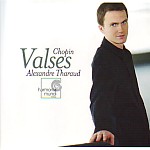Considering how popular some of them are, it’s startling to find oneself in agreement with Alexandre Tharaud’s rationale for devoting his first Chopin disc entirely to the waltzes: “The waltzes aren’t much recorded nowadays. When they’re played in concert it’s as display pieces. I wanted to position them differently, going back to the tradition of pianists such as Dinu Lipatti and Samson François, who didn’t hesitate to give them a personal order and structure and play the set complete, like a large cycle.” Indeed, the last unambiguously great recording of the more-or-less complete waltzes probably was Rubinstein’s, dating from the mid-1960s. Tharaud offers a more comprehensive survey than either Rubinstein or Lipatti: 19 pieces in all (as opposed to 14), and his achievement is every bit as impressive.
Like the Mazurkas, many of the waltzes are deceptively simple. Consider the little E major piece (op. posth.), a work so technically unprepossessing that in my piano-playing days even I managed to get through it. Here, Tharaud demonstrates that he’s as smart as he is technically adroit, shaping the music in long phrases that follow such a clear harmonic trajectory that the work acquires a poetic depth that you’d hardly believe possible. Or consider Op. 34 No. 2, which Chopin calls a “Grande valse brilliante”, but at the same time marks “lento”. How to reconcile its subdued character with the pianistic glitter that seems to want to burst forth at any moment (but never quite does)? Tharaud shows us, through sensitive rubato and rhythmic control, keeping the music in a state of suspensefully sustained tension from first note to last.
Looking at the score while listening, it’s fascinating to see how few dynamic markings Chopin includes, and how open this leaves the music to exaggeration and the occasional interpretive excess. Even the great Lipatti attacks the famous C-sharp minor Waltz (Op. 64 No. 2) initially with something close to insensitivity. In this same work, Tharaud captures just as much momentum as his illustrious predecessor, without quite so much hardness of tone. He’s by no means a slave to the score–it’s just that when he deviates it always makes good musical sense. At the end of this waltz, for example, Chopin marks the final reprise “pianissimo”. Tharaud begins a bit louder than that, but only so as to be able to observe the magical decrescendo in the final bars all the more generously. Little touches like this bring the music to life.
Tharaud opens with the A minor waltz (op. posth.) and concludes with an outburst of joy in the form of Op. 18 in E-flat major. All of the minor-key works appear roughly in the first half of the set (ending at track 11, containing Op. 69 No. 2 in B minor). The effect is of darkness yielding to light, and it’s obvious that Tharaud has given as much thought to matters of large-scale organization as he has to questions of pianistic detail. He places three of the A-flat major waltes, followed by the three in E-flat major, at the end of the set, and the resultant tonal stability offers the same firm feeling of resolution as does the finale of Beethoven’s Fifth. The placement of the famous “Minute Waltz” (Op. 64 No. 1) right after the B minor also is a brilliant stroke, creating a moment of high contrast that makes continuous listening a compelling experience. There’s even an encore, a wonderfully apt summing-up and musical commentary in the form of Mompou’s Valse-Évocation (Variations on a Theme of Chopin). Gorgeous sonics and perceptive booklet notes make this charismatic and elegant Chopin experience even more rewarding. Simply divine. [5/31/2006]
































